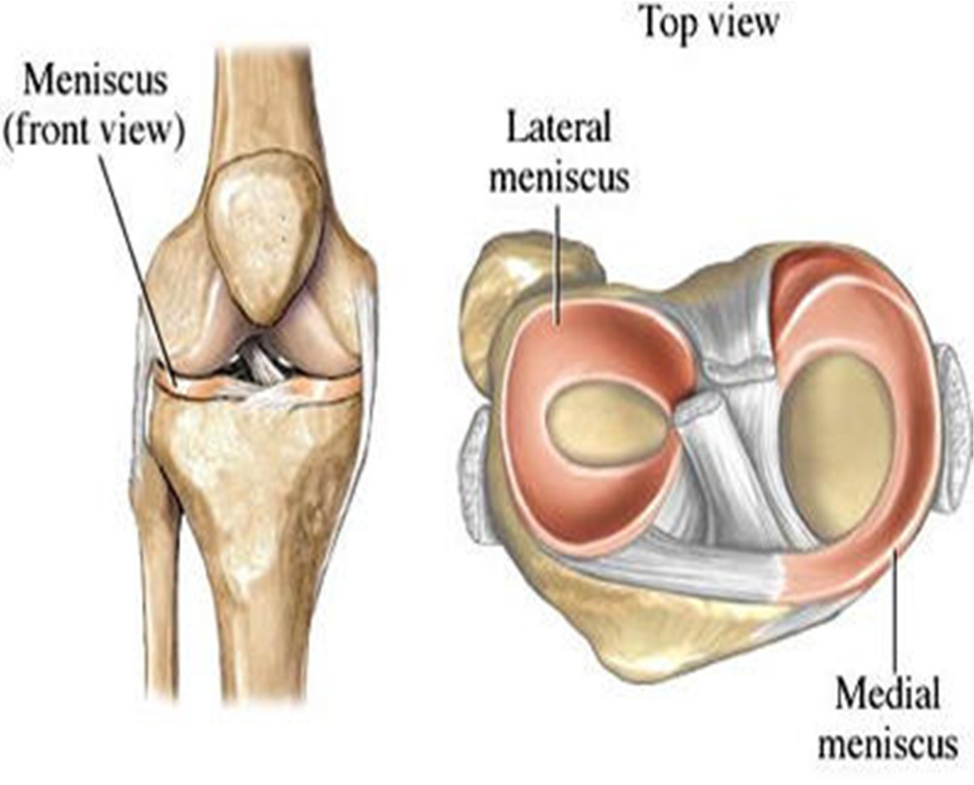- Home
- Injuries to Medial Meniscus
Injuries to Medial Meniscus
MENISCUS INJURIES
The medial meniscus and lateral meniscus are specialized structures within the knee. These crescent-shaped shock absorbers between the tibia and femur have an important role in the function and health of the knee. Once thought to be of little use, the menisci (plural) were routinely removed when torn. Now we know that the menisci contribute to a healthy knee because they play important roles in joint stability, force transmission, and lubrication. When possible, they are repaired if injured. There are even experimental attempts to replace a damaged meniscus, possibly an important advance in orthopaedic medicine.

Symptoms
What are the signs and symptoms of a meniscus injury?
Acute tears are often sports related and usually the result of a twisting injury in the younger, active adult population. Symptoms of an acute tear are usually pain, swelling, and movement irregularities. When the tear gets in the way of normal knee motion, the knee can “catch” or “lock” as it moves.
Degenerative tears are more common in the older population. The patient may experience repeated swelling, but often can’t recall any specific injury. The swelling also may be the result of an injury caused by a very minor movement. Mechanical symptoms, such as the knee catching or locking, often exist. Or, the patient may simply experience pain.
BOOK AN APPOINTMENT
“KNEEO Technique” For Knee Replacements
What is a meniscus injury?
Patients describe meniscal tears in a variety of ways. Knowing where and how a meniscus was torn helps the doctor determine the best treatment.
- Location -A tear may be located in the anterior horn, body, or posterior horn. A posterior horn tear is the most common. The meniscus is broken down into the outer, middle, and inner thirds. The third in which the tear is located will determine the ability of the tear to heal, since blood supply in that area is critical to the healing process. Tears in the outer 1/3 have the best chance of healing.
- Pattern – Meniscal tears come in many shapes. The pattern of the tear influences the doctor’s decision on treatment. Examples of the various patterns are:
- longitudinal
- bucket-handle
- displaced bucket handle
- parrot beak
- radial
- displaced flap
- horizontal
- degenerative
- A complex tear includes more than one pattern.
- Completeness – A tear is classified as being complete or incomplete. A tear is considered complete if it goes all the way through the meniscus and a piece of the tissue is separated from the rest of the meniscus. If the tear is still partly attached to the body of the meniscus, it is considered incomplete.
- Stability – A tear can be stable or unstable. A stable tear does not move and may heal on its own. An unstable tear allows the meniscus to move abnormally and is likely to be a problem if it is not surgically corrected.
Categories of meniscal injuries
What are the signs and symptoms of a meniscus injury?
Acute tears are often sports related and usually the result of a twisting injury in the younger, active adult population. Symptoms of an acute tear are usually pain, swelling, and movement irregularities. When the tear gets in the way of normal knee motion, the knee can “catch” or “lock” as it moves.
Degenerative tears are more common in the older population. The patient may experience repeated swelling, but often can’t recall any specific injury. The swelling also may be the result of an injury caused by a very minor movement. Mechanical symptoms, such as the knee catching or locking, often exist. Or, the patient may simply experience pain.


